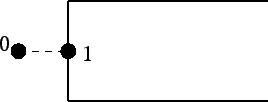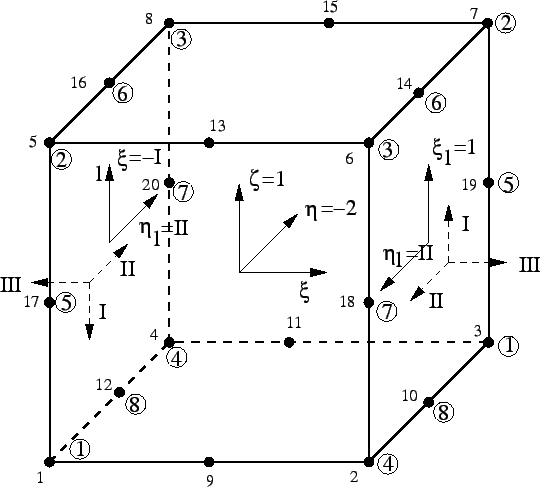



Next: Contact
Up: Expansion of the one-dimensional
Previous: Applying concentrated forces to
Contents
Figure 162:
Expansion of a beam element
 |
In beam elements the section forces can be requested at the end nodes. To this
end the stresses in the expanded faces at the end nodes are integrated. How
this is done can be explained by looking at Figure 162.
The stresses in the expanded element are at first determined in the integration
points (e.g. the Gauss-Kronrod points, cf. Figure 80). Then,
they are expanded to the nodes of the element. Consequently, the stresses are
available at all 20 nodes of the element in Figure 162. In order
to obtain the section force the following local coordinate systems are
introduced:
- The local element
 -system.
-system.  is along the axis of
the beam (from the first node of the element to the last node),
is along the axis of
the beam (from the first node of the element to the last node),  is along the user-defined 1-direction of the beam,
is along the user-defined 1-direction of the beam,  corresponds to the minus 2-direction. The 2-direction is defined such that
corresponds to the minus 2-direction. The 2-direction is defined such that
 -1-2 corresponds to a positive axis system.
-1-2 corresponds to a positive axis system.
- On the positive face of the beam element (the face corresponding to the
last end node of the beam definition, i.e.
 ) the positive direction
for the section forces, which is denoted by I, II and III in Figure
162 corresponds to the element 1-direction, 2-direction and
) the positive direction
for the section forces, which is denoted by I, II and III in Figure
162 corresponds to the element 1-direction, 2-direction and  .
.
- On the negative face of the beam element the positive direction for the
section forces, denoted by I, II and III points in the other direction of
the corresponding axes on the positive face (action=reaction).
- The local node numbering within the positive face is labeled by 1 to 8
in small circles and corresponds to a local coordinate system
 =
=
 coinciding with the system I-II.
coinciding with the system I-II.
- The local node numbering within the negative face is also labeled by 1
to 8 in small circles and corresponds to a local coordinate system
 = -I,II =
= -I,II =
 .
.
The system I-II-III in the faces denotes the positive direction of the section
forces. The location of the integration points in the corresponding
 system is obtained from the local element coordinate system
system is obtained from the local element coordinate system
 through the above face-dependent relationships.
through the above face-dependent relationships.
In order to get the section forces the stresses are calculated in the
integration points of the positive and negative face by interpolation from the
stresses at the nodes belonging to the respective face. The integration point
scheme depends on the beam section.




Next: Contact
Up: Expansion of the one-dimensional
Previous: Applying concentrated forces to
Contents
guido dhondt
2018-12-15

 -system.
-system. ![]() system is obtained from the local element coordinate system
system is obtained from the local element coordinate system
 through the above face-dependent relationships.
through the above face-dependent relationships.